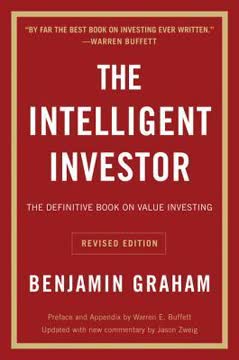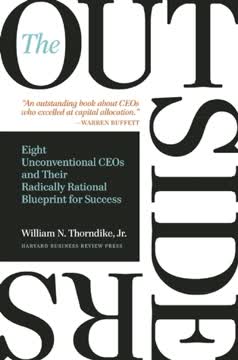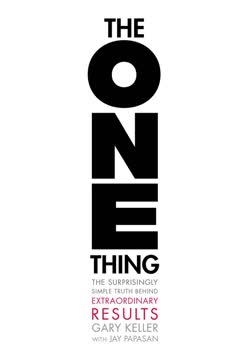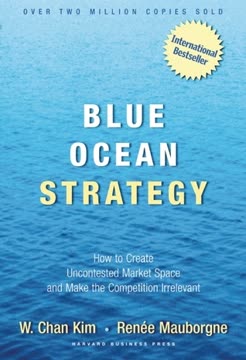Key Takeaways
1. Define the Full Potential: Uncover Your Company's True Value
"How high is up?"
Rigorous assessment. Defining your company's full potential requires a comprehensive evaluation of its current state and future possibilities. This process involves conducting a strategic due diligence that examines derived demand, customer analysis, competitive landscape, environmental factors, and microeconomic drivers.
Focus on key initiatives. Once you've identified the full potential, concentrate on the 3-5 most critical initiatives that will drive value creation. This focused approach ensures resources are allocated efficiently and prevents the organization from spreading itself too thin.
- Elements of strategic due diligence:
- Derived demand analysis
- Customer analysis
- Competitive analysis
- Environmental analysis
- Microeconomic analysis
2. Develop the Blueprint: Create an Actionable Roadmap
"The blueprint brings the initiatives to life."
Detailed action plan. The blueprint is a strategic operating plan that translates your full-potential thesis into concrete actions. It outlines specific steps, resources, timelines, milestones, metrics, and deliverables for each key initiative.
Collaborative process. Developing the blueprint should involve your senior management team in an intensive planning process. This collaborative approach ensures buy-in and alignment across the organization. Consider using an outside facilitator to foster collaboration and maintain momentum.
- Key components of a blueprint:
- Specific actions for each initiative
- Resource allocation
- Timelines and milestones
- Performance metrics
- Clear accountability
3. Accelerate Performance: Execute with Precision and Speed
"Accelerating performance means monitoring a few key metrics."
Organizational alignment. To accelerate performance, mold your organization around the blueprint. This involves matching talent to key initiatives and ensuring that each activity has a clear owner who is accountable for results.
Program management. Implement program management tools, such as a dedicated program office, to drive implementation and ensure initiatives stay on track. This structure helps coordinate cross-functional efforts and resolve potential conflicts.
Key performance indicators. Focus on tracking a few critical metrics that provide leading indicators of success. These should be operational measures that look forward and spur action, rather than backward-looking financial metrics.
- Examples of forward-looking metrics:
- Number of high-value customers acquired
- Revenue churn rate
- Lease-up rate (for real estate companies)
- Cash conversion cycle
4. Harness the Talent: Build a High-Performing Team
"PE firms are absolutely unbending in their insistence on performance."
Talent assessment. Conduct a rigorous evaluation of your existing team to identify top performers and potential gaps. Be prepared to make tough decisions about personnel changes if necessary to achieve your full-potential goals.
Recruitment strategy. When hiring new talent, look for individuals with both the necessary skills and an "at cause" attitude – those who are proactive problem-solvers and take ownership of results. Consider casting a wide net beyond your immediate industry to find fresh perspectives.
Incentive alignment. Create compensation structures that tie rewards directly to performance and value creation. This may include equity ownership, phantom equity, or other long-term incentive plans that foster an ownership mentality among key employees.
- Characteristics of high-performing talent:
- Proven track record of success
- Willingness to take calculated risks
- Strong leadership and team-building skills
- Ability to drive change and innovation
5. Make Equity Sweat: Optimize Your Capital Structure
"Every dollar of equity is precious, and I have to maximize the return on that dollar."
Leverage optimization. Embrace an appropriate level of debt to create a more efficient capital structure. This approach forces discipline in cash management and can lead to higher returns on equity.
Working capital management. Aggressively manage working capital by optimizing inventory levels, improving receivables collection, and extending payables where possible. This frees up cash for debt service or reinvestment in growth initiatives.
Asset efficiency. Scrutinize your balance sheet to identify underutilized or non-core assets that can be monetized or divested. Consider innovative financing structures, such as sale-leasebacks, to unlock value from fixed assets.
- Areas to focus on for capital efficiency:
- Inventory turnover
- Days sales outstanding (DSO)
- Days payables outstanding (DPO)
- Fixed asset utilization
- Non-core business divestments
6. Foster a Results-Oriented Mindset: Create a Culture of Accountability
"I tell my people, 'Here is the framework. I want you to spend 50 percent of your time doing what you are supposed to do, but spend 50 percent on telling me how you can create more value.'"
Clear accountability. Establish a culture where individuals at all levels feel ownership for results. Push decision-making authority down to the most effective level and ensure that managers are held responsible for delivering on their commitments.
Continuous improvement. Encourage employees to constantly seek ways to enhance performance and create value. This mindset should permeate the organization, from the factory floor to the executive suite.
Effective communication. As a leader, clearly articulate the vision for change and consistently reinforce the message through various channels. Use a mix of technology and personal interactions to keep the organization focused on key initiatives and milestones.
- Strategies for fostering accountability:
- Regular performance reviews tied to specific metrics
- Open-door policies for idea sharing
- Recognition and rewards for value-creating initiatives
- Transparent tracking of progress against goals
7. Embrace Private Equity Disciplines: Learn from the Best Investors
"The best PE firms have replaced passive stewardship with a hands-on approach to building value in their portfolio companies."
Active ownership. Adopt a proactive approach to value creation, similar to how private equity firms manage their portfolio companies. This involves setting ambitious targets, actively monitoring performance, and quickly intervening when necessary.
Value-creation focus. Prioritize initiatives that directly contribute to increasing the company's equity value. This may require challenging traditional practices and making bold strategic moves to unlock hidden potential.
Exit mindset. While public companies don't have a defined exit timeline, adopting a PE-like mentality can help focus efforts on building sustainable value. Regularly ask yourself: "How would we prepare this business for sale to maximize its value?"
- Key PE disciplines to emulate:
- Rigorous due diligence and valuation
- Aggressive performance targets
- Rapid decision-making and execution
- Regular reassessment of strategy and initiatives
8. Conduct Strategic Due Diligence: Challenge Conventional Wisdom
"In God we trust. All others bring data."
Fact-based analysis. Approach strategic decisions with a skeptical mindset, relying on hard data and thorough analysis rather than conventional wisdom or industry assumptions. This may involve conducting primary research or engaging external experts to gain fresh insights.
Comprehensive scope. Examine all aspects of the business and its environment, including market trends, customer needs, competitive dynamics, and internal capabilities. Look for hidden opportunities or risks that may not be apparent at first glance.
Ongoing process. Treat strategic due diligence as a continuous activity, not just a one-time event. Regularly reassess your assumptions and update your understanding of the business landscape to stay ahead of emerging trends and challenges.
- Key areas for strategic due diligence:
- Market size and growth potential
- Customer segmentation and needs
- Competitive positioning and differentiation
- Regulatory and technological trends
- Internal capabilities and constraints
9. Focus on Cash Generation: Prioritize Financial Health
"In a leveraged business, managing cash always takes priority over managing earnings."
Cash flow focus. Shift your financial management approach to prioritize cash generation over reported earnings. This means closely monitoring and optimizing the components of cash flow, including working capital, capital expenditures, and debt service.
Capital allocation discipline. Apply rigorous criteria to capital investment decisions, ensuring that each project delivers a strong return on invested capital. Be willing to divest or shut down underperforming assets or business units to free up cash for more productive uses.
Financial flexibility. Maintain sufficient financial flexibility to weather economic downturns and capitalize on growth opportunities. This may involve maintaining a cash reserve or securing committed credit lines.
- Key cash management metrics:
- Free cash flow
- Cash conversion cycle
- Return on invested capital (ROIC)
- Debt service coverage ratio
- Working capital as a percentage of sales
10. Align Incentives: Motivate Through Ownership Mentality
"The management team may get 5 to 10 percent of the equity in the company going in and get the opportunity to earn another 20 percent, meaning that they get more than a quarter of the value of the company at the end of the (typical) three- to five-year investment period."
Equity participation. Offer key employees the opportunity to own a meaningful stake in the company's success through equity grants or options. This aligns their interests with those of shareholders and encourages long-term thinking.
Performance-based rewards. Design compensation structures that directly link pay to performance, with a significant portion tied to achieving specific value-creation targets. This may include both short-term and long-term incentive components.
Broad-based incentives. Extend the ownership mentality throughout the organization by implementing profit-sharing or stock purchase plans for all employees. This fosters a culture of shared responsibility and collective success.
- Elements of an effective incentive system:
- Clear performance metrics tied to value creation
- Significant upside potential for exceptional results
- Balanced mix of short-term and long-term incentives
- Regular communication of progress and potential payouts
11. Leverage the Board: Utilize Expertise for Value Creation
"PE owners give the boards of directors of their portfolio companies much running room."
Value-added board. Assemble a board of directors with diverse expertise relevant to your key strategic initiatives. Look for individuals who can provide practical insights and guidance, not just oversight.
Active engagement. Encourage board members to actively contribute their knowledge and networks to support value creation. This may involve assigning specific board members to mentor executives or advise on particular initiatives.
Efficient governance. Streamline board processes to focus on the most critical strategic issues and decisions. Minimize time spent on routine matters and maximize substantive discussions that can drive value creation.
- Characteristics of an effective board:
- Industry and functional expertise aligned with company strategy
- Willingness to challenge management constructively
- Strong understanding of value creation levers
- Regular involvement in strategy development and review
Last updated:
FAQ
What's "Lessons from Private Equity Any Company Can Use" about?
- Focus on PE Lessons: The book explores how private equity (PE) strategies can be applied to any business to enhance value creation.
- PE Industry Insights: It provides insights into the PE industry, highlighting its role in the global economy and its impact on business practices.
- Practical Application: The book offers practical advice for executives on implementing PE strategies to improve company performance.
- Comprehensive Guide: It covers various aspects of business management, including defining potential, developing blueprints, and fostering a results-oriented mindset.
Why should I read "Lessons from Private Equity Any Company Can Use"?
- Learn from Experts: Authored by Orit Gadiesh, a global expert on management strategy, the book provides authoritative counsel.
- Time-Starved Executives: It's tailored for busy executives, offering concise and focused solutions to management challenges.
- Broaden Business Perspective: Gain a deeper understanding of how PE firms operate and how their strategies can be adapted to different business environments.
- Enhance Business Value: The book provides actionable insights to help leaders make their companies more valuable and competitive.
What are the key takeaways of "Lessons from Private Equity Any Company Can Use"?
- Define Full Potential: Understand the importance of setting clear, ambitious goals for your company's growth and value.
- Develop the Blueprint: Create a detailed, actionable plan to achieve your company's full potential.
- Accelerate Performance: Focus on organizational change and performance metrics to drive success.
- Harness Talent and Make Equity Sweat: Use incentives and leverage to maximize talent and financial resources.
How can the lessons from private equity be applied to any company?
- Strategic Due Diligence: Conduct thorough analysis to understand your company's market position and potential.
- Focus on Key Initiatives: Identify and concentrate on a few critical initiatives that will drive the most value.
- Leverage and Cash Management: Embrace leverage and manage cash flow aggressively to fund growth and operations.
- Results-Oriented Culture: Foster a culture that prioritizes results and continuous improvement.
What is the "Private Equity Advantage" according to Orit Gadiesh?
- Value Creation Focus: PE firms excel at creating value through strategic planning and operational improvements.
- Short to Medium-Term Goals: They focus on achieving significant returns within a three to five-year timeframe.
- Operational Efficiency: PE firms prioritize efficiency and effectiveness in all aspects of business operations.
- Talent and Incentives: They use equity and performance-based incentives to align management with company goals.
What are the six key lessons from private equity that any business can use?
- Define the Full Potential: Set ambitious goals for growth and value creation.
- Develop the Blueprint: Create a detailed plan to achieve these goals.
- Accelerate Performance: Implement changes and track progress with key metrics.
- Harness the Talent: Recruit, retain, and motivate top talent with incentives.
- Make Equity Sweat: Use leverage and manage resources efficiently.
- Foster a Results-Oriented Mindset: Create a culture focused on achieving results.
How does "Lessons from Private Equity Any Company Can Use" suggest defining a company's full potential?
- Strategic Due Diligence: Conduct a thorough analysis of market drivers, customer needs, and competitive landscape.
- Set Ambitious Targets: Determine what the company could be worth in three to five years.
- Identify Key Initiatives: Focus on a few critical initiatives that will drive the most value.
- Challenge Conventional Wisdom: Be willing to make bold moves and embrace change.
What is the role of a "blueprint" in achieving a company's full potential?
- Action-Oriented Plan: The blueprint is a strategic operating plan that details how to achieve full potential.
- Resource Allocation: It outlines the resources, timelines, and actions needed for each initiative.
- Alignment and Excitement: Helps create alignment within the organization and builds excitement around key initiatives.
- Continuous Improvement: The blueprint is revisited and updated regularly to ensure ongoing progress.
How does "Lessons from Private Equity Any Company Can Use" recommend accelerating performance?
- Organizational Alignment: Mold the organization around the blueprint and match talent to key initiatives.
- Ownership and Accountability: Assign ownership of initiatives to specific individuals and hold them accountable.
- Program Management Tools: Use tools like program offices to track progress and resolve issues.
- Monitor Key Metrics: Focus on operational and financial metrics that indicate progress toward goals.
What strategies does "Lessons from Private Equity Any Company Can Use" suggest for harnessing talent?
- Performance-Based Incentives: Use equity and bonuses to align management with company goals.
- Recruitment and Retention: Attract top talent by offering competitive compensation and growth opportunities.
- Value-Added Boards: Assemble boards with members who bring valuable expertise and can provide strategic guidance.
- Continuous Development: Invest in training and development to enhance skills and capabilities.
How does "Lessons from Private Equity Any Company Can Use" define "making equity sweat"?
- Leverage Utilization: Embrace leverage as a cost-effective way to finance growth.
- Cash Flow Focus: Prioritize cash generation over earnings to ensure financial health.
- Efficient Capital Management: Aggressively manage working capital, capital expenditures, and balance sheet assets.
- Maximize Returns: Ensure every dollar of equity is used efficiently to maximize returns.
What are the best quotes from "Lessons from Private Equity Any Company Can Use" and what do they mean?
- "Your most important task as a leader is to make your company more valuable." This emphasizes the core responsibility of leaders to focus on value creation.
- "The best PE firms have set a concrete and inescapable benchmark for global business performance." Highlights the high standards set by PE firms that other businesses can aspire to.
- "Every dollar of equity is precious, and I have to maximize the return on that dollar." Stresses the importance of efficient capital management and maximizing returns.
- "Fostering a results-oriented mind-set is about creating repeatable, sustainable processes in your company." Encourages the development of a culture focused on continuous improvement and results.
Review Summary
Lessons from Private Equity Any Company Can Use receives mixed reviews, with an average rating of 3.80 out of 5. Some readers find it concise and valuable, praising its practical lessons and clear recommendations. Others criticize it for being too short and lacking depth. The book outlines six techniques for increasing company value, focusing on defining potential, developing plans, and creating a results-oriented culture. While some consider it a useful refresher, others feel it offers little new information and is somewhat superficial.
Similar Books










Download PDF
Download EPUB
.epub digital book format is ideal for reading ebooks on phones, tablets, and e-readers.




